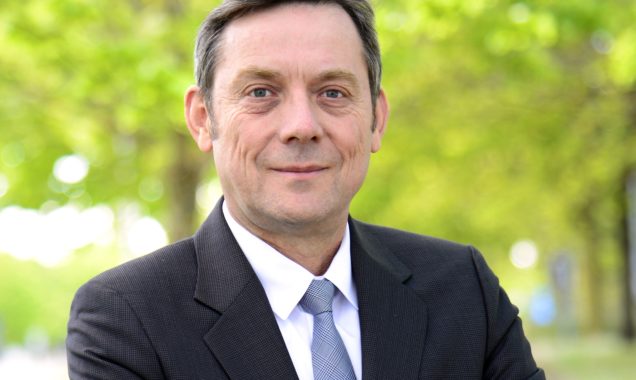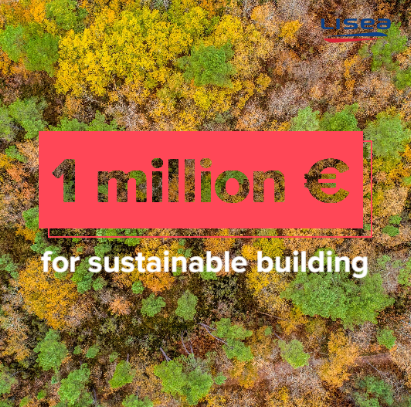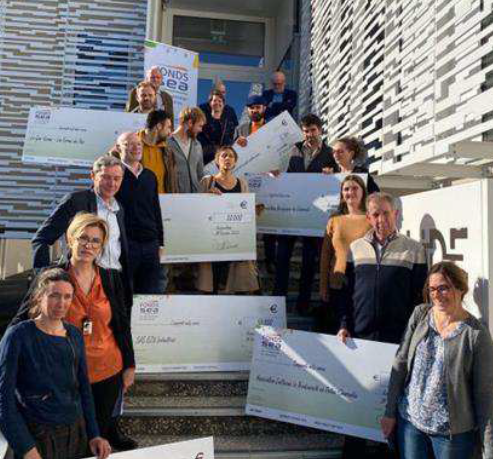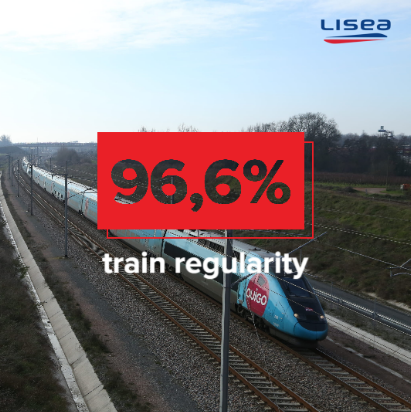
who we are
LISEA, CONCESSION HOLDER OF THE SOUTH EUROPEAN ATLANTIC HIGH SPEED RAILWAY LINE & SUSTAINABLE MOBILITY ACTOR
Concession holder of the South European Atlantic High Speed Railway line connecting Tours & Bordeaux (SEA HSR), operating since July 2nd 2017, LISEA is the first private company in France to manage an infrastructure dedicated to high speed railway links.

2022 marks five years since the opening of the SEA high-speed line. Over the past five years, the HSL has established itself as a major link in the national and European network, becoming the second-busiest HSL in France. The year 2022 also confirmed rail as a major lever for decarbonising modes of transport, for the ecological transition and for regional dynamics. In this context, LISEA’s role is to encourage the emergence of new rail transport services to meet the public’s growing demand for sustainable mobility, while supporting the regions crossed by the SEA HSL in forwarding their environmental approach and boosting their attractiveness.


HERVÉ LE CAIGNEC LISEA Chairman
Connecting
Facilitate opening up to competition and develop new transport services
Following on from 2021, rail has been identified as a powerful lever for the climate and the ecological transition. In view of these challenges, opening up to competition, which is an essential condition for increasing rail services, would appear to be a major asset for the environment, for the social and economic development of the regions, and for passengers. In actual fact, however, competition remains very limited.
In this context, LISEA has made the successful opening up of the market one of its major priorities for 2022. In order to facilitate and accelerate its implementation, LISEA has taken part in specialised French and European circles and conferences to emphasise how vital this is, both in terms of developing rail services and forwarding the ecological transition (ATEC-ITS Congress, European Mobility Expo, PRIME* platform, UIC meetings, “Les nouveaux aventuriers du rail” conference organised by Mobilettre and Le Train).
(*) Platform of Rail Infrastructure Managers in Europe
« SMR »
A key element in successfully opening up the market, the project for a Maintenance and Repairs Site (Site de Maintenance et de Remisage – SMR) for trains capable of travelling at high speed (Trains Aptes à la Grande Vitesse – TAGV), which the company has been leading since 2018, has made major progress. Two public meetings (on 14 June and 7 November) provided an opportunity to present developments in the project, to discuss and debate with local residents and, above all, to enrich the project. Governance based on consultation and dialogue has enabled us to take into account feedback from residents and come up with practical solutions, particularly in terms of noise protection and landscape integration.
| A prerequisite for the successful development of rail services in the Nouvelle-Aquitaine region and south-west France, the SMR would remove one of the main barriers to entry encountered by new operators: access to maintenance facilities and rolling stock storage. The maintenance centres are located in Ile-de-France and Lyon, and managed by SNCF Voyageurs. The creation of an SMR near Bordeaux, to complement the existing maintenance facilities, therefore represents a concrete solution to facilitate the arrival of new operators and thus increase the rail services serving south-west France. |

Commercial assistance
At the same time, from 2024, LISEA will offer development assistance for all new services launched on the SEA HSL. This measure, aimed at all operators, new entrants such as SNCF Voyageurs, involves a degressive reduction over five years in the amount of fees, up to 50% in the first year.
 New Paris-La Rochelle rail service via SEA
New Paris-La Rochelle rail service via SEA
Since 16 December 2022, OuiGo has been offering high-speed train services to Paris<>La Rochelle four days a week, from Friday to Monday, via Poitiers, Niort and Surgères stations.
Acting
For safety
Safety authorisation renewed for LISEA and MESEA
On 22 March 2022, LISEA and MESEA, the line’s maintainer, obtained renewal of their safety authorisation from the EPSF (Établissement Public de Sécurité Ferroviaire) for a five-year period, without any reservations.
Issued for the first time in 2017, this authorisation confirms the ability of the concessionaire and maintainer to meet regulatory safety requirements and control the risks associated with the design, construction, maintenance, renewal and operation of the SEA HSL. This decision testifies to the relevance of the operational organisation and resources implemented by LISEA in order to guarantee the highest standards in terms of rail traffic safety, infrastructure availability and the durability of installations.
AGIR
For the regions
LOTI and BIANCO reports
In accordance with the regulations, LISEA submitted the BIANCO and LOTI reports on the environmental and socio-economic aspects of the SEA HSL to the French government in December 2022, five years after the line was commissioned. The aim of these ex-post assessments is not only to compare the reality on the ground after commissioning with the initial assessment, but also to provide feedback and improve knowledge in the context of major infrastructure projects.
Two feedback days on these reports will be scheduled in the fourth quarter of 2023.
ACTING
A COMMITTED CSR APPROACH
Promoting sustainable building and social inclusion
In July 2022, the SEA Fund for regional transition (Fonds SEA pour la transition des territoires), supported by LISEA and MESEA, reaffirmed its commitment to the ecological transition of the regions crossed by the SEA HSL and to local initiatives, by committing €1 million to sustainable building.
- Firstly, through a partnership with Odéys (the Nouvelle-Aquitaine region’s sustainable construction and development cluster), supporting building projects investing in the circular economy and biosourced materials as part of the BDNA (Bâtiments Durables en Nouvelle-Aquitaine) approach – €700,000.
- Then, via the call for projects “Supporting structures for integration through economic activity (SIAE) in the development of the circular economy for sustainable construction” – €300,000. These concrete measures are fully in line with the Neo Terra regional roadmap and meet France’s commitments under the European Green Deal to divide greenhouse gas emissions by four by 2050.
15 winners of the “Supporting local and sustainable agriculture” call for projects
Following the first call for projects launched in April 2021, the SEA Fund selected 15 winners, all players in the ecological and inclusive transition in the six departments crossed by the high-speed line. These organisations will now benefit from logistical support and financial backing for their projects until 2026, totalling €500,000.
Each winning organisation will work on one of the following three areas depending on its project: the environmental performance of farms, the local development of a sustainable, solidarity-based organic market gardening industry, and research and experimentation to relocate the plant protein industry.
LISEA’s carbon footprint
In 2022, LISEA assessed the carbon footprint of its activities over the entire concession period. This assessment covers the construction of the SEA HSL, its maintenance as well as works and multiannual investment operations, and the traction energy needed to run the trains.
A LISEA-MESEA action plan will be rolled out in 2023 to reduce greenhouse gas emissions and integrate carbon issues into the company’s projects.
Improving CSR performance
LISEA has launched a project to structure its CSR policy around six themes:
- Guaranteeing the security of the infrastructure;
- Committing to the development of low-carbon mobility and helping to combat climate change;
- Preserving biodiversity and reducing our impact on natural resources;
- Adopting an inclusive and fair company policy to support employees’ personal development;
- Working alongside our stakeholders to promote the dynamism and ecological transition of the regions crossed by the SEA HSL;
- Consolidating a corporate culture aligned with business ethics and sharing it throughout our value chain.



 Environmental measures
Environmental measures
98%
of the 738 ha of the sites under agreement that were inspected in 2022 comply with the specifications
INNOVATING
For operational and environmental performance
AI and DATA for the maintenance of the SEA HSL
LISEA has always placed innovation at the heart of its approach to performance and safety, in particular by professionalising data analysis methods and developing tools that leverage and optimise the data available on the infrastructure.
In 2022, the LISEA and MESEA teams will continue to ramp up their data engineering skills by integrating the line’s switches into the SEACloud general data analysis tool. This application, called “Aigu[IA]ge”, is used to monitor the condition of switches and understand their deterioration process. This is an indispensable tool to help the business experts of the concessionaire and maintainer understand and model switch and crossing deterioration in the short and medium term so as to optimise maintenance and renewal.
A new project, ISO[IA], was launched at the end of 2022. Its aim is to model variations in electrical cable insulation in order to prevent and locate faults and thus avoid incidents that could have a major impact on traffic.
SEACloud
Among the innovations deployed, the SEACloud platform, developed by LISEA and MESEA, enables data from the SEA HSL to be stored, secured and used, as well as integrating and predicting new data. As the cornerstone of the LISEA-MESEA data infrastructure, SEACloud is used to monitor the condition of the infrastructure and optimise track geometry, a crucial element in anticipating and optimising maintenance operations and methods, and extending the lifecycle of the SEA HSL.
CompenSEA: the first data centralisation platform for environmental measures
Designed by LISEA, CompenSEA is the first digital platform for managing compensatory measures. This is an innovative solution for collecting, centralising and pooling data on the 330 compensation measure sites spanning the SEA HSL, spread over 3,800 hectares, with all the players involved (including government departments and environmental associations). The objective? To facilitate governance and monitoring planning, and share in real time the information needed to manage compensation measures. A new version went live in December 2022.





 New Paris-La Rochelle rail service via SEA
New Paris-La Rochelle rail service via SEA Environmental measures
Environmental measures